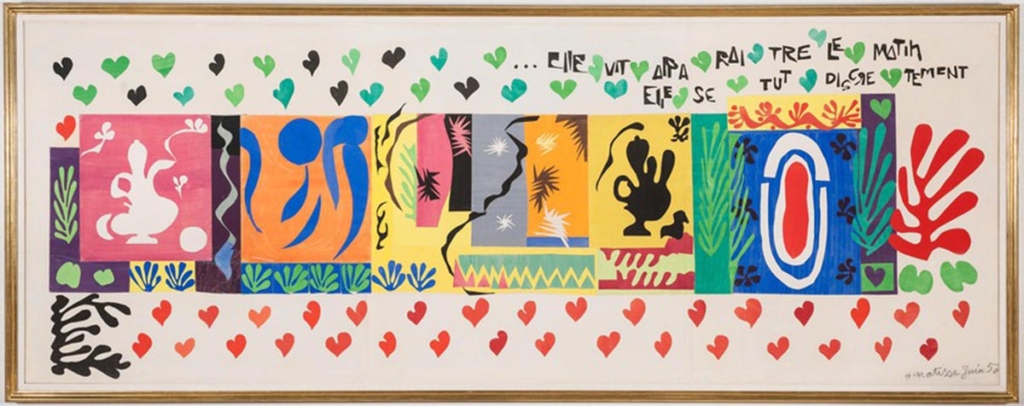Towards the end of his life, Henri Matisse developed a new way of making art. An ongoing illness left him homebound, and during that time, he became inspired by paper. He moved away from drawing and painting and began to make compositions from cut pieces of painted paper. Matisse called his process “drawing with scissors.” His famous explorations of color and line exploded into energetic collages known as cut-outs.
This cut-out from Carnegie Museum of Art’s collection is based on the story of Scheherazade from The One Thousand and One Nights. If you look at the painting from left to right, the story begins with a lamp lit at nightfall, then continues past the stars in the night sky and other symbols, and finally moves to another silhouette of the lamp, which has expired with the rising sun. The sentence at the upper right, written in French, features an important quote from the story: “As dawn approached, she discreetly fell silent.”

Discuss with These Questions:
- What other shapes do you see in Matisse’s composition?
- Shapes can mean different things to different people. What do the shapes mean to you? What do the shapes mean to those around you? How do your interpretations differ, or are they the same?
- What new story might you be able to tell using the shapes you see?
Get Creative: Make Your Own Drawing with Scissors
To follow along with this activity, make sure that you have some scissors, white paper, glue, and anything you can use to make color on your paper: crayons, markers, colored pencils, paint, etc.
Over his career, Matisse created compositions exploring the relationships between shapes and colors. He cut the shapes out of paper, and then his studio assistants arranged and rearranged them at Matisse’s direction. The leaf shape in Carnegie Museum of Art’s composition is taken from the plants in Matisse’s studio. He was inspired by shapes that he found all around him and used them repeatedly. He used not only the shapes that he cut out (positive shapes), but the paper from which they were cut (negative pieces).
- First, color some pieces of white paper. Set a few pieces of plain paper aside to use as background paper. Matisse often combined colors on one piece of paper. Make some pieces by layering colors on top of one another. What new colors can you make?
- Look around your home. What interesting shapes can you find in the objects around you—maybe the leaf on a plant, or an interesting silhouette outside your window? Draw the outline in pencil on your colored paper and then cut out the shape. Do this as often as you like with different colors of paper. Keep both the positive shapes and the negative pieces of the paper.
- Working by yourself or with someone else, arrange and rearrange your new shapes on a piece of background paper. What do you notice each time you move them? What if some are upside down? What if you move the shapes onto their sides?
- Notice how different colors interact with one another. What colors do you like next to each other? Why?
- What do you notice when you add the negative pieces to the composition?
- Glue the pieces to the background paper in your preferred arrangement, and then make another one!